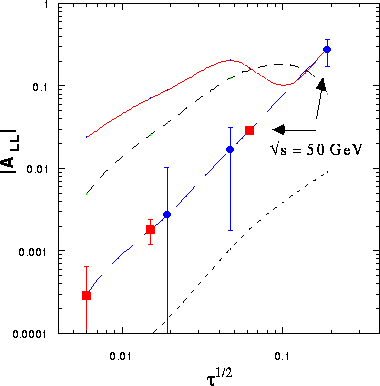 and production are
usually discussed in terms of parton fusion models which rely on bound-state
phenomenology[38] for identifying various possible production mechanisms. Two
paths which are likely to contribute to
and production are
usually discussed in terms of parton fusion models which rely on bound-state
phenomenology[38] for identifying various possible production mechanisms. Two
paths which are likely to contribute to  () production are,
() production are,
Asymmetries for  and production are
usually discussed in terms of parton fusion models which rely on bound-state
phenomenology[38] for identifying various possible production mechanisms. Two
paths which are likely to contribute to
and production are
usually discussed in terms of parton fusion models which rely on bound-state
phenomenology[38] for identifying various possible production mechanisms. Two
paths which are likely to contribute to  () production are,
() production are,

and

One expects the
 resonance to be produced primarily via the second path, since its
mass lies above the
resonance to be produced primarily via the second path, since its
mass lies above the  region.
The parton-level
asymmetry for indirect production via the
region.
The parton-level
asymmetry for indirect production via the  state is maximally large and independent of kinematics,
state is maximally large and independent of kinematics,  .
Theoretical evidence[36,38] and experimental data from hadron
production of
.
Theoretical evidence[36,38] and experimental data from hadron
production of
 [39] suggest that
[39] suggest that
 of the cross section is via this path at fixed-target energies.
Unfortunately the asymmetry for the three-gluon mechanism has the opposite sign to the
of the cross section is via this path at fixed-target energies.
Unfortunately the asymmetry for the three-gluon mechanism has the opposite sign to the
 production path, resulting in cancellation[36]. In the dominant
kinematic region,
production path, resulting in cancellation[36]. In the dominant
kinematic region,  , one finds[36]
, one finds[36]  . Nevertheless, using a model which includes both direct and indirect production of the
. Nevertheless, using a model which includes both direct and indirect production of the
 and resonances, Doncheski and Robinett[36] predict sizable values,
and resonances, Doncheski and Robinett[36] predict sizable values,
 , near
, near  .
.
Production of the  ,
,  , and resonances
, and resonances![]() produces substantial yield in the dimuon
channel in the RHIC energy range as is evident in Table 2.
produces substantial yield in the dimuon
channel in the RHIC energy range as is evident in Table 2.

Table 2: Numbers of pairs accepted into the upgraded PHENIX
spectrometer for an integrated luminosity of
 .
.
Lower limit errors (neglecting
background subtraction and systematic errors) may be calculated as
 ,
where
,
where  is the proton beam polarization.
is the proton beam polarization.
In order to get a qualitative picture of asymmetries in quarkonium production,
Fig. 11 shows  for several published structure
functions[31,32,33,34]. Equation 13
has been used with
for several published structure
functions[31,32,33,34]. Equation 13
has been used with  , approximating the cancellation between the two production
mechanisms as calculated by Doncheski and Robinett[36]. The polarized structure
functions of Refs.[31,32,33] have the property
, approximating the cancellation between the two production
mechanisms as calculated by Doncheski and Robinett[36]. The polarized structure
functions of Refs.[31,32,33] have the property
 over much of the x range.
Equation 13 then becomes,
over much of the x range.
Equation 13 then becomes,

Thus there is no dependence on  , and polarization effects increase linearly with
, and polarization effects increase linearly with  . The
points in Fig. 11 are plotted on the curve of Ref.[32] with errors determined by the
numbers of Table 2. Both
. The
points in Fig. 11 are plotted on the curve of Ref.[32] with errors determined by the
numbers of Table 2. Both  and data would be most significant in constraining the current models
at the lowest collision energy.
and data would be most significant in constraining the current models
at the lowest collision energy.

Figure 11: Asymmetries using the polarized structure functions of
Ref.[34] (solid), Ref.[33]
(medium dash), Ref.[32] (long dash), and Ref.
[31] (short dash). A parton-level asymmetry,
 has been assumed. The points show error
estimates for
has been assumed. The points show error
estimates for  (squares) and (circles)
production described in the text.
(squares) and (circles)
production described in the text.